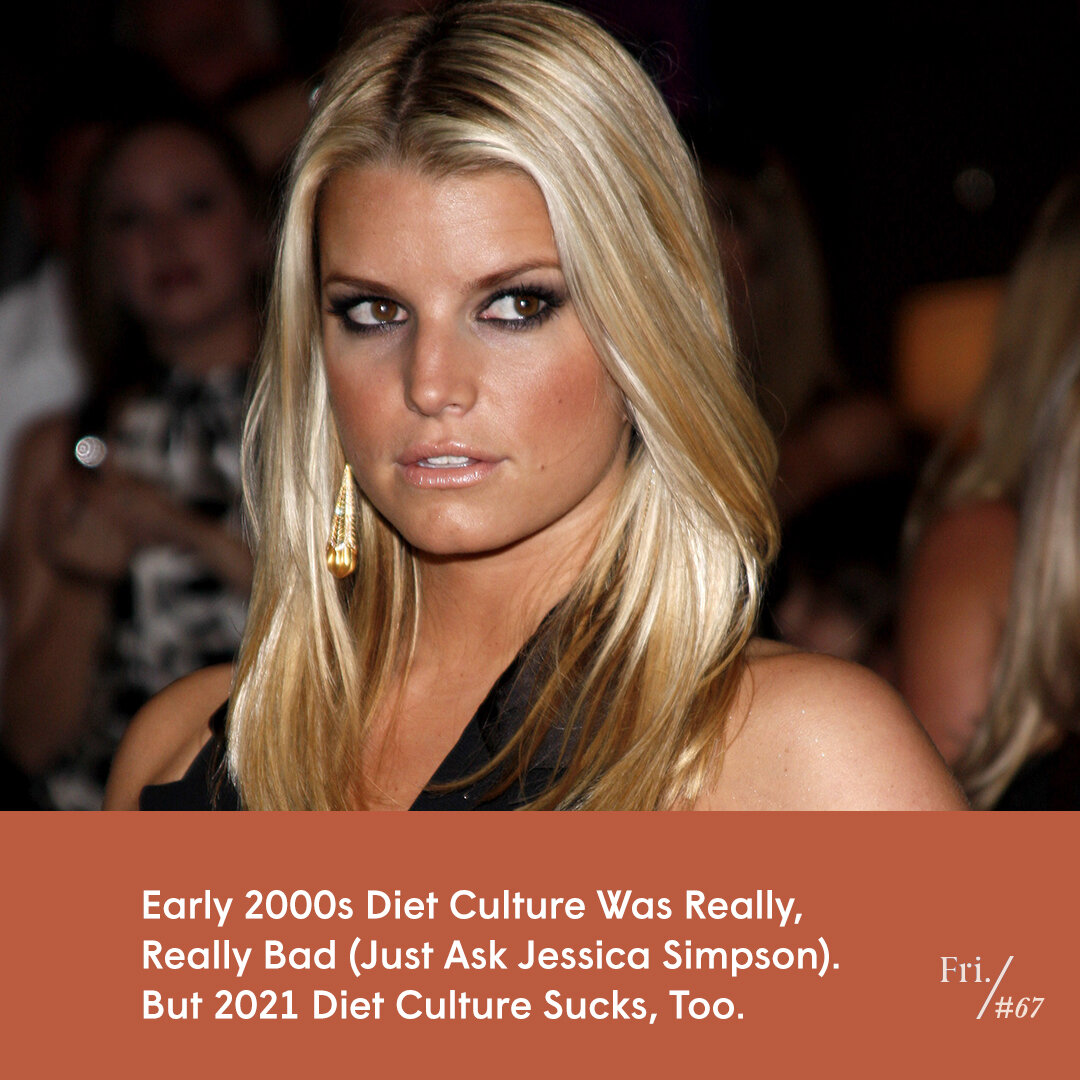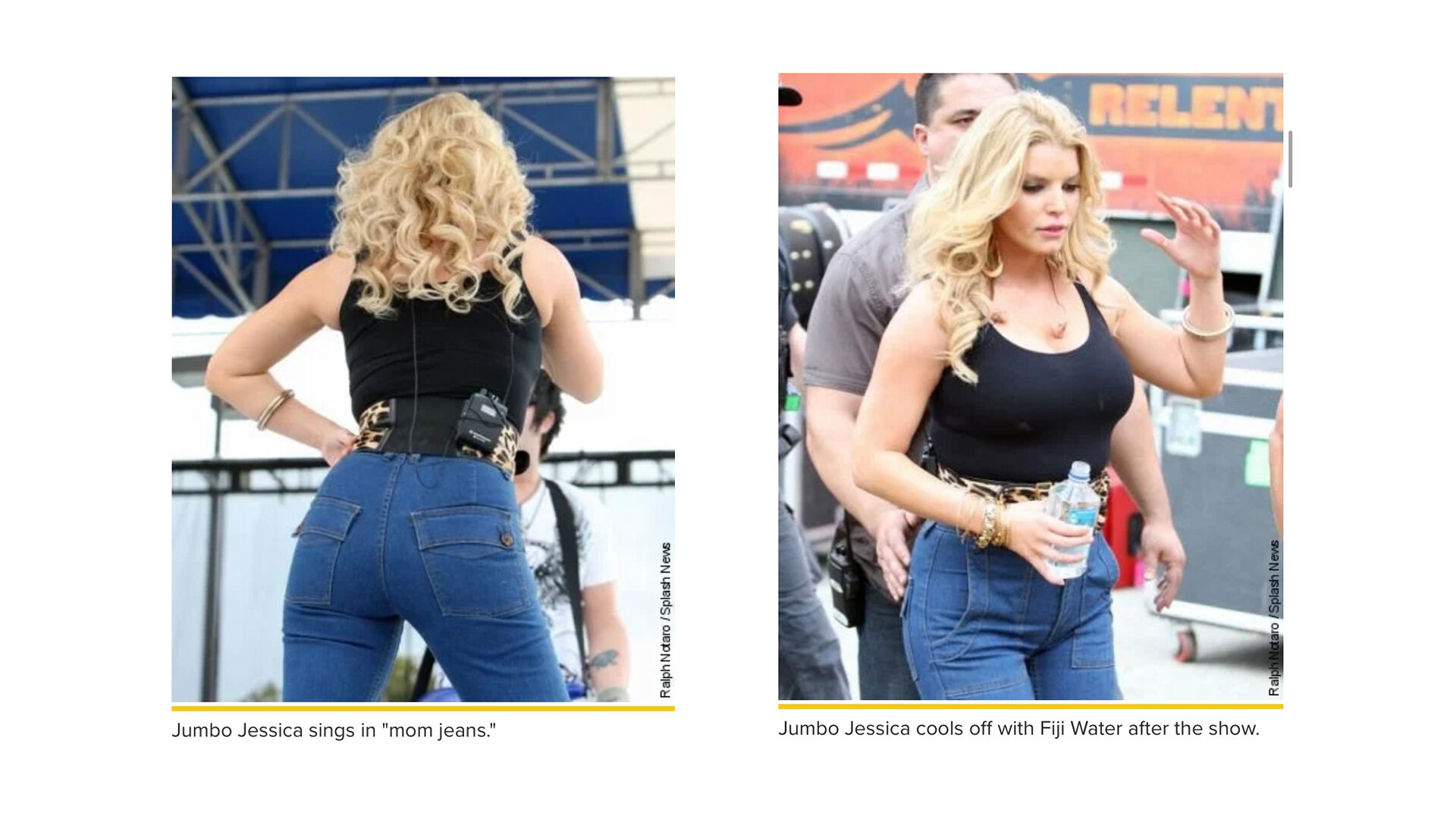A Tweet About Early 2000s Diet Culture Went Viral This Week. Here's What It Missed
By Stacy Lee Kong
Image: Shutterstock
Content warning: This newsletter contains references to body image, disordered eating and general diet culture fuckery and images of very thin celebrities.
If you’re a millennial woman who’s been on Twitter this week, you’ve likely seen this post by McSweeney's editor Lucy Huber: “if any Gen Z are wondering why every Millennial woman has an eating disorder it’s because in the 2000s a normal thing to say to a teenage girl was ‘when you think you feel hungry, youre [sic] actually thirsty so just drink water and you’ll be fine,’” she posted on Wednesday. “Love to be gaslit about what hunger is!!!”
Which… yeah, that’s legit. I don’t have an eating disorder but somewhere between the third and seventh time I saw this retweeted onto my timeline, I realized I do have a solid 20 years of accumulated ‘wisdom’ on how to restrict my diet in the hopes of controlling my body—which is, by definition, disordered eating—gleaned largely from the magazines I read (and later worked for). Closely related to the ‘you’re not actually hungry, you’re dehydrated’ idea, there was the trick of drinking water before a meal to fool your stomach into thinking you were full. And let's not forget the demonization of carbs; the rule that you shouldn’t eat ‘bad’ foods unless it’s a ‘cheat day’; the tip about not eating after 7:30 p.m. (not even a grape, according to Oprah); the idea that fruits are bad (too much sugar), but ‘calorie-negative’ foods, which supposedly require more energy to eat and digest than they actually contain, are good (this is bullshit, by the way). There's probably even more than I'm forgetting, tbh.
And that's in addition to the pervasive imagery that glamorized thinness during my most formative years. When I was a kid in the 90s, I completely missed the drug references in fashion’s heroin chic era, but I definitely grasped the idea that being thin was beautiful. The message was only hammered home by the aesthetics of the early oughts, when every starlet seemed to have an impossibly flat midriff that was on full display thanks to the ultra low-rise jeans and crop tops that were in style at the time. And if I didn't get it then, it was certainly instructive to see the media backlash when they dared to gain weight. (Or, in the case of Jessica Simpson's infamous performance at a Florida chili cook-off in 2009, wore somewhat unflattering pants.)
This is how Page Six talked about Jessica Simpson after she wore mom jeans to perform at a Florida chili cook-off in 2009.
I didn't mean to internalize any of this. In high school, when I was just discovering feminism, I would purposefully seek out ‘bad’ foods as an act of resistance... which also wasn't a healthy approach to food. But just because I was aware of how terrible this messaging was doesn't mean I could escape its impact. In fact, I'm still trying to unlearn these ideas about what I 'should' look like. No lie: on Tuesday, before Huber even tweeted this, I literally thought to myself, ‘are you hungry, or did you not drink enough water today?’ In retrospect, it's easy to see that our bodies were held to deeply fucked up standards, and that they've been difficult to shake. No wonder so many of us want to talk about it.
But, I don’t think we should fall into the trap of believing that young women today are not being exposed to these exact same messages, or are somehow immune to these ideas. We might want to believe that because Gen Zers are more informed, braver and progressive than many of us were in our teens and early 20s, they’re less likely to buy into these harmful beauty ideals but that's not actually true. That's... kind of the whole point of propaganda, right? It gets you even when you're smart, and sometimes even when you see it coming.
To be fair, early 2000s pop culture was a garbage fire
That said, I get why Huber framed her tweet as an explanation to Gen Z—the way we talk about our bodies has changed drastically even just in the past five years, and the more we say we value diversity and body positivity, the more corporations embrace those movements to sell their products. It feels like a huge change, so it’s not unreasonable to believe (or maybe just hope) that younger women aren’t going through what we went through.
Plus, in comparison to the late 90s and early oughts, it really does look like we’re in a body positivity paradise. Remember celebrity stylist Rachel Zoe’s signature look, most often seen on Nicole Richie, Lindsay Lohan, Mischa Barton and Paris Hilton? “Bug-eyed sunglasses and gilets, stacks of chunky bangles and trailing scarves, distressed denim and Grecian dresses, no-bra-needed tops and waitlist-definitely-needed supersized handbags tucked into the crook of a scrawny arm… It was a sort of ’70s tribute act reworked for the early 21st century [that] became inextricable from the glorification of size zero. The cartoonish proportions only served to exaggerate those jutting hipbones, spaghetti limbs and protruding clavicles,” Laura Antonia Jordan pointed out last year in a Grazia article that made the case for leaving that particular trend in the early 2000s, where it belongs.
Even if we did see what were supposed to be representations of different body types back then, they were… not actually plus-size, as lifestyle blogger Rosey Blair has been breaking down on TikTok. The ‘fat’ stepsister in Ever After? Not fat. The ‘chubby’ kid in Now and Then? The same size as all the other kids, actually.
And Simpson wasn't the only one getting body-shamed by the tabloids. Despite what Page Six and the like might have written, Renee Zellweger, Kate Winslet and Alicia Silverstone were only slightly larger than your average female celebrity. (And again, the average female celebrity was extremely skinny at the time.)
And of course, many women’s mags were oh so helpfully explaining just how these celebrities got, and stayed, so thin. I distinctly remember reading an article that claimed the same stars who were ordering juicy burgers to appear relatable—or maybe because they were literally starving—were also dousing their food with water or covering it with salt after a few bites, so they wouldn’t actually eat it all.
Diet culture has morphed—but it’s still very much alive
It’s a far cry from what we see now: plus-size models walking in major runway shows, a growing (but still far too small) number of retailers that offer so-called expanded sizing and influencers and celebrities who are accumulating followers—and brand partnerships—for their body positive content.
All of which makes it easy to believe that diet culture is dead, or at least dying. But… is that actually the case?
I don’t think so. Every January, media still pushes the same old 'new year, new you' content, conflating getting healthy with losing weight, even though literally all the evidence we have says diets don’t actually work. And despite the body positivity movement become increasingly mainstream in recent years, the global prevalence of eating disorders actually rose by 4.3% between 2000 and 2018, according to an April 2019 article in The American Journal of Clinical Nutrition (AJCN). This isn’t just about representation or what magazines say about our bodies, of course. Eating disorders are mental illnesses that can be caused by a complex variety of factors, including genetics, biology, psychology and social factors—including what's happening in the world on a global scale. In fact, “it appears that the prevalence and severity of eating disorders may be spiking even more due to the anxiety and stress unleashed by the COVID-19 pandemic,” according to a recent article from the American Society for Nutrition.
But we also have to admit that things haven’t changed as much as we think they have, or maybe wish they have. You used to be able to find “pro-ana” tips and tricks pretty easily on Tumblr or teen girls’ blogs. Then, they migrated to Pinterest and Instagram. Now, fatphobic content is all over TikTok, despite the app’s attempts to crack down on videos that promote starvation and anorexia. Maybe the celebrities we’re obsessed with in 2021 are slim thick instead of alarmingly skinny, but a key hallmark of this look is a flat stomach and slim waist—a look that, for most people, is impossible to achieve.
Because the root cause of diet culture—controlling women’s bodies—hasn’t gone anywhere
Even though publications have pledged to be more thoughtful when writing about weight and health, our society hasn’t stopped prioritizing thinness. We’ve just repackaged those old, harmful ideas about our what our bodies should look like in the muted earth tones of ‘wellness.’ As novelist Jessica Knoll wrote in the New York Times in 2019, wellness, an industry that is now worth between $3 and $3.5 trillion in the U.S. alone, is “a dangerous con that seduces smart women with pseudoscientific claims of increasing energy, reducing inflammation, lowering the risk of cancer and healing skin, gut and fertility problems. But at its core, ‘wellness’ is about weight loss. It demonizes calorically dense and delicious foods, preserving a vicious fallacy: Thin is healthy and healthy is thin.”
Don't get me wrong—the way we talk about our bodies is changing, and I have totally seen a shift in what gets presented as beautiful. Gen Z is coming of age in a different world than I did. But diet culture is still very much a thing. In fact, it can't go anywhere, for any generation or, for that matter any gender, until we actually grapple with why we are so obsessed with thinness... which is definitely not about health. It is about upholding a very specific type of body—white, cisgender, thin, pretty—as a societal ideal, and then coercing all of us who don’t fit that mould, especially Black and racialized women, into doing whatever it takes, which usually means buying something or buying into something, to approximate the aesthetic.
I don't think Huber meant to frame her tweet as a traumatic take on the middle part debate. It's just easy to see how prevalent body positive messaging is now and believe the youth have it easier than millennials did. But we shouldn't look at unrealistic beauty standards on a generation-by-generation basis, because the language might be different, but the message is the same.
And Did You Hear About…
Some of the Canadian journalists who signed an open letter calling for nuance and context in our coverage of Israel and Palestine being reprimanded by their newsrooms, and sometimes being barred from covering this story.
This extremely wholesome moment.
The latest backlash against Kendall Jenner’s tequila brand.
Rebecca Jennings’ very smart analysis on whose content gets surfaced the most by TikTok’s algorithm, and why it’s often the most boring people.
This brilliant profile of Sinead O’Connor that completely reframes the narrative around her career.


